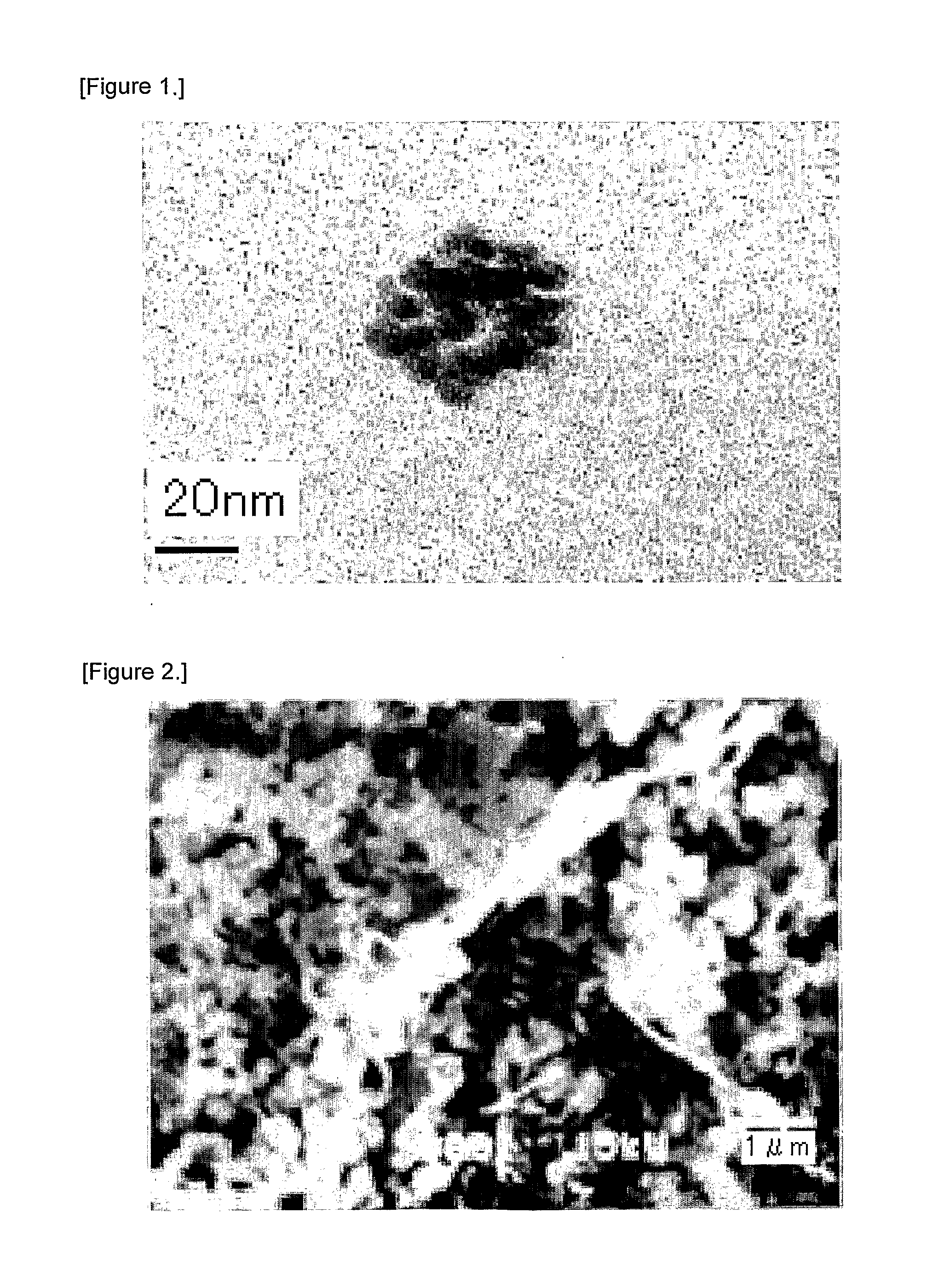Metal Particle Dispersion Structure, Microparticles Comprising This Structure, Articles Coated With This Structure, And Methods Of Producing The Preceding
- Summary
- Abstract
- Description
- Claims
- Application Information
AI Technical Summary
Benefits of technology
Problems solved by technology
Method used
Image
Examples
example 1
[0176]To a crosslinkable organopolysiloxane composition comprising[0177](a1-1) 5.11 g of vinyl-functional organosiloxane resin given by the average compositional formula
[(CH2═CH)(CH3)SiO2 / 2]0.10[(CH3)2SiO2 / 2]0.15[(C6H5)SiO3 / 2]0.75,[0178](a1-2) 2.02 g of vinyl-functional organosiloxane given by the molecular formula
[(CH2═CH)(CH3)2SiO1 / 2]2[(C6H5)2SiO2 / 2],[0179](a1-3) 2.02 g of vinyl-functional organosiloxane given by the molecular formula
[(CH2═CH)(CH3)2SiO1 / 2]3[(C6H5)SiO3 / 2],[0180](a2) 5.74 g of organohydrogensiloxane resin given by the average compositional formula
[H(CH3)2SiO1 / 2]0.6[(C6H5)SiO3 / 2]0.4,[0181](a3) 0.002 g of platinum·divinyltetramethyldisiloxane complex,[0182](b3-1) 5.11 g of toluene, and
0.02 g of tris(1,1-dimethyl-2-propynoxy)methylsilane was added a toluene solution of a metal complex, prepared by dispersing (b2) 0.05 g of silver laurate (AgOCOC10H21) in (b3-2) 2.0 g of toluene, and mixing to homogeneity was carried out by stirring.
[0183]The resulting mixture was coate...
example 2
[0185]For component (A),[0186](a1-1) 20.0 g of vinyl-functional organosiloxane resin given by the average formula
[(CH2═CH)(CH3)2SiO1 / 2]0.25[(C6H5)SiO3 / 2]0.75,[0187](a2-1) 3.93 g of organohydrogensiloxane given by the molecular formula
[H(CH3)2SiO1 / 2]2[(C6H5)2SiO2 / 2], and[0188](a2-2) 3.93 g of organohydrogensiloxane given by the molecular formula
[H(CH3)2SiO1 / 2]3[(C6H5)SiO3 / 2],
were mixed to homogeneity. To this mixture was added a separately prepared toluene solution containing a gold (III)-hexylamine complex (prepared by the addition of (b3-1) 10.0 g of toluene to (b2) 0.25 g of NaAuCl4 and 0.14 g of hexylamine (C6H13NH2) with dissolution to homogeneity), and mixing to uniformity was carried out by stirring. The resulting fluid mixture was held for 2 hours at 80° C. and then returned to room temperature. To the resulting mixture were then added, with thorough mixing, (a3) 0.01 g of platinum divinyltetramethyldisiloxane complex, (b3-2) 10.0 g of toluene, and 0.1 g of tris(1,1-dimethyl-...
example 3
[0191]The following were mixed to homogeneity:[0192](a1-1) 5.11 g of vinyl-functional organosiloxane resin given by the average compositional formula
[(CH2═CH)(CH3)SiO2 / 2]0.10[(CH3)2SiO2 / 2]0.15[(C6H5)SiO3 / 2]0.75,[0193](a1-2) 2.02 g of vinyl-functional organosiloxane given by the molecular formula
[(CH2═CH)(CH3)2SiO1 / 2]2[(C6H5)2SiO2 / 2],[0194](a1-3) 2.02 g of vinyl-functional organosiloxane given by the molecular formula
[(CH2═CH)(CH3)2SiO1 / 2]3[(C6H5)SiO3 / 2], and[0195](a2) 5.74 g of organohydrogensiloxane resin given by the average formula
[H(CH3)2SiO1 / 2]0.6[(C6H5)SiO3 / 2]0.4.
To this mixture was added a separately prepared toluene solution containing a copper (II)-hexylamine complex (prepared by the addition of (b3-1) 5 g of toluene to (b2) 0.05 g of copper chloride (CuCl2) and 0.10 g of hexylamine (C6H13NH2) with dissolution to homogeneity), and mixing to uniformity was carried out by stirring under nitrogen. The resulting mixture was held for 3 hours at 80° C. and then returned to room t...
PUM
| Property | Measurement | Unit |
|---|---|---|
| Temperature | aaaaa | aaaaa |
| Thickness | aaaaa | aaaaa |
| Thickness | aaaaa | aaaaa |
Abstract
Description
Claims
Application Information
 Login to View More
Login to View More - R&D
- Intellectual Property
- Life Sciences
- Materials
- Tech Scout
- Unparalleled Data Quality
- Higher Quality Content
- 60% Fewer Hallucinations
Browse by: Latest US Patents, China's latest patents, Technical Efficacy Thesaurus, Application Domain, Technology Topic, Popular Technical Reports.
© 2025 PatSnap. All rights reserved.Legal|Privacy policy|Modern Slavery Act Transparency Statement|Sitemap|About US| Contact US: help@patsnap.com


